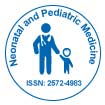Apgar: Assessing Newborn Health at Birth
Received: 03-Feb-2025 / Manuscript No. nnp-25-171020 / Editor assigned: 06-Feb-2025 / PreQC No. nnp-25-171020 / Reviewed: 18-Feb-2025 / QC No. nnp-25-171020 / Revised: 22-Feb-2025 / Manuscript No. nnp-25-171020 / Published Date: 28-Feb-2025 DOI: 10.4172/2572-4983.1000505
Introduction
The Apgar score is a vital tool used to assess the health and well-being of newborns immediately after birth. Developed in 1952 by Dr. Virginia Apgar, an American anesthesiologist, this scoring system provides a quick and objective evaluation of a baby’s physical condition, allowing healthcare providers to identify infants who may require urgent medical attention. The term “Apgar” is both the name of its creator and an acronym representing five critical criteria: Appearance, Pulse, Grimace, Activity, and Respiration. By evaluating these five indicators, the Apgar score helps ensure timely intervention and contributes significantly to neonatal care worldwide [1], [2].
Discussion
The Apgar score is performed at one minute and five minutes after birth. In some cases, a further evaluation may be done at ten minutes if the baby requires additional support. Each of the five criteria is assigned a score from 0 to 2, with a maximum total of 10 points. A high score, typically 7 to 10, indicates that the newborn is in good health and generally requires only routine postnatal care. A score of 4 to 6 suggests moderate difficulty, prompting close monitoring and possibly medical assistance. Scores below 4 indicate severe distress, necessitating immediate intervention such as resuscitation [3], [4].
The five components of the Apgar score each provide specific insights into the newborn’s condition. Appearance examines skin color, noting whether the baby has healthy pink coloring or signs of cyanosis. Pulse measures the heart rate, which is a critical indicator of cardiovascular function. Grimace evaluates the baby’s reflex response to stimuli, such as a mild pinch, reflecting neurological status. Activity assesses muscle tone, observing whether the baby moves actively or appears limp. Respiration monitors breathing effort, noting whether it is strong, weak, or absent. Together, these criteria offer a holistic view of the newborn’s immediate health status [5], [6].
The Apgar score is not intended to predict long-term health outcomes but rather to provide an immediate snapshot of the newborn’s condition. It allows healthcare professionals to quickly identify life-threatening issues such as respiratory distress, low heart rate, or poor oxygenation [7], [8]. Over the decades, the Apgar score has become a universally recognized standard in obstetrics and neonatology, contributing to improved survival rates and better initial care for newborns. Additionally, the simplicity and speed of the test make it particularly valuable in emergency situations and resource-limited settings [9], [10].
Conclusion
The Apgar score remains an essential component of neonatal care, offering a rapid, reliable method for assessing a newborn’s health immediately after birth. By evaluating appearance, pulse, grimace, activity, and respiration, healthcare providers can quickly identify infants in need of urgent medical attention, thereby improving survival rates and outcomes. While the Apgar score does not predict long-term development, its role in the first critical minutes of life is invaluable. The system’s simplicity, efficiency, and effectiveness have ensured its continued use across the globe, making it a cornerstone of safe and effective newborn care.
References
- Angelica VG, Tracy AM (2018) Screening for spontaneous preterm birth and resultant therapies to reduce neonatal morbidity and mortality: A review. Semin Fetal Neonatal Med 23: 126-132.
- Joice SM, Tricia SF, Raquel CGL, Veronica CV, Danielle SDM (2021) Premature birth: topics in physiology and pharmacological characteristics. Rev Assoc Med Bras 67: 150-155.
- Wen LL, Chang WH, Wang HW (2021) Risk factors associated with preterm premature rupture of membranes (PPROM). Taiwan J Obstet Gynecol 60: 805-806.
- Goligher, Ewan C (2012) Ventilator-Induced Diaphragm Dysfunction. Anesthesiology 117: 463–464.
- Stein H (2013) Electrical Activity of the Diaphragm [Edi] Values and Edi Catheter Placement in Non-Ventilated Preterm Neonates. Am. J. Perinatol. 33:707–711.
- Chiew Yeong Shiong (2013) Effects of Neurally Adjusted Ventilatory Assist [NAVA] Levels in Non-Invasive Ventilated Patients: Titrating NAVA Levels with Electric Diaphragmatic Activity and Tidal Volume Matching. BioMedical Engineering OnLine 2:12-61.
- Beck Jennifer (2009) Patient-Ventilator Interaction during Neurally Adjusted Ventilatory Assist in Low Birth Weight Infants. Pediatric Research 65:663–668.
- Stein, Howard (2012) Synchronized Mechanical Ventilation Using Electrical Activity of the Diaphragm in Neonates. Clinics in Perinatology 39:525–542.
- Kallio Merja (2012) Electrical Activity of the Diaphragm during Neurally Adjusted Ventilatory Assist in Pediatric Patients. Pediatric Pulmonology.50: 925–931.
- Rahmani A (2012) Neurally Adjusted Ventilatory Assist in the Neonatal Period: Applications and Limitations. Journal of Neonatal-Perinatal Medicine5: 205–212.
Citation: Beatriz F (2025) Apgar: Assessing Newborn Health at Birth. Neonat Pediatr Med 11: 505. DOI: 10.4172/2572-4983.1000505
Copyright: © 2025 Beatriz F. This is an open-access article distributed under the terms of the Creative Commons Attribution License, which permits unrestricted use, distribution, and reproduction in any medium, provided the original author and source are credited.
Select your language of interest to view the total content in your interested language
Share This Article
Recommended Journals
Open Access Journals
Article Tools
Article Usage
- Total views: 224
- [From(publication date): 0-0 - Dec 11, 2025]
- Breakdown by view type
- HTML page views: 163
- PDF downloads: 61
